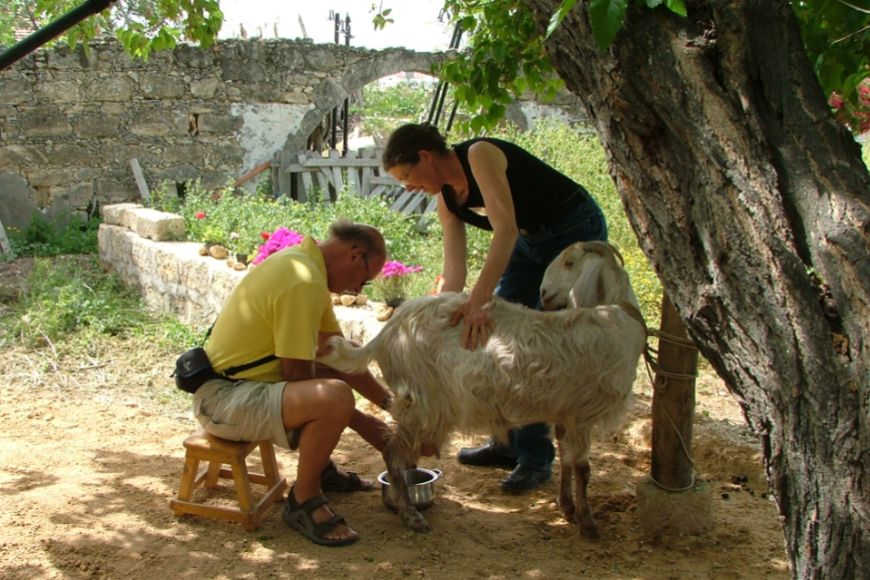Oct 15, 2023
Memories from a Kudu
by Penny C.
Northern Cyprus (2007) showed us goats' inherent design flaw as the American returnee fished (with her finger) poo out of the bucket as she demonstrated how to milk her goats.
The wall-creeper emerging from its nest in that horrendous and now crumbling Soviet-era ‘friendship’ artwork in Georgia (2012) was great, and not only for its Ozymandias overtones. Later, where a dam is being built almost on the border with Russia (and near where Pompey sensibly turned back his legions), the tone in which our guide said: ‘If it fails the water goes THAT way’, said all one needed to know about the current state of that friendship. Animal skulls nailed over the entrance doors of village churches were also an interesting sight.
Bulgaria (2005) was memorable for my first wall-creeper, encountering grout coloured to match the surrounding bathroom tiles, Fi’s ‘kidnap’ of a state archaeologist in charge of a horse-burial who the previous week had assured her it would be open and it wasn't, and observing how people had adapted (or not) to the post-Soviet world.
Although bad weather prevented our final walk in Armenia (2008), it meant we saw an impressive migration of raptors coming through a low pass forced to fly low because of the sleet and snow. Visiting a neglected Zoroastrian cemetery just before that and seeing the ancient tombs of mounted horsemen was pretty special. (Trouble on the border had meant we couldn’t visit the petroglyphs near Mt Mets Ishkhanasar so I am really looking forward to seeing those in Kyrgyzstan.)
The painted churches in Romania (2010) are very spectacular, but I knew what to expect and such places had the money to hire the best artists; much more special for me were the little wooden village churches with their painted scenes around the outside, the colours now faded and the style unsophisticated. Churches, which like so many deeply rural English ones, needed someone (in Romania generally a small boy) to go and find the lady with the key. Such ladies seem international, although definitely not in secular France. Along broadly similar lines on my first visit to Istria (2018) it was very local knowledge than enabled Kudu to find the restaurant where the key holder (the priest this time) was having his lunch that day! And last year that tiny early church decorated by Master Ambrose of Constance David and Tereza had found since 2018.
Being in the Registan in Samarkand on our trip to Uzbekistan (2014) as the light was beginning to fade and the swifts were screaming around that collection of magnificent buildings was stunning, but again I knew what I would be seeing. Thus the Shah-i Zinda, the ‘lane’ of magnificent blue-tiled tombs, which was a surprise, was perhaps even better.
There are so many ’snapshots’: tripe soup at a roadside ‘cafe’ in Georgia, pelicans in Bulgaria rising on a morning thermal from their roost to spend the day on the Danube delta, flights problems that meant it was too late to visit Mahler’s summer composing ‘hut’ en route to our base in the Dolomites (2017), but a spectacular thunderstorm not only compensated but explained where so many of his sound effects came from! And later on that same drive a ’stream’ of white pheasant-eye narcissi ‘flowing' across a field in the fading light.
My two most memorable moments are from Poland and the Ukraine (2011) and Romania.
In Poland and Ukraine we were walking along the low almost downland ridge that features in many a Kudu brochure and on the website, when sweeping low up the left-hand (northern) slope came hundreds and hundreds of migrating swallows. For a few moments we were surrounded in a maelstrom of birds as they swept across the ridge and down the southern slope, feeding as they went. It lasted a few seconds and was magical.
In Romania, while we picnicked near the cheese-makers who were also having lunch I had noticed two or three metal bugle-like objects hanging by the fire where they smoked the cheeses. After some time one of the young men got up, went over, took down one of the objects, put it to his lips and blew a few notes. After a brief pause a distant, slightly different, call came in response. That too was magical. They were communicating as generations of such young men had done, though I wonder if their sons are still.
When I think of Kudu these two moments always first to come to mind and, if put up against a wall, I could not choose between them. I think the reason I find them so special is that they occurred absolutely regardless of us, our presence was merely coincidental.


